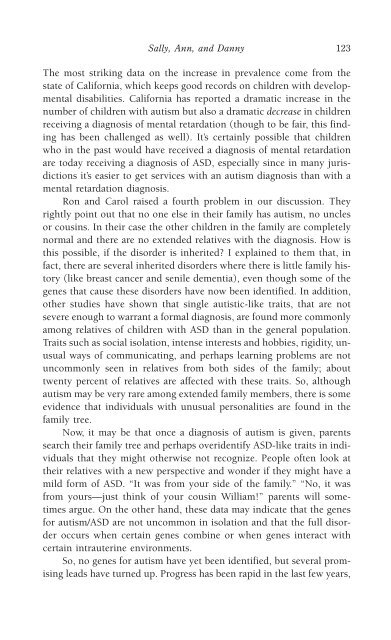978-1572305441
autism
autism
You also want an ePaper? Increase the reach of your titles
YUMPU automatically turns print PDFs into web optimized ePapers that Google loves.
Sally, Ann, and Danny 123<br />
The most striking data on the increase in prevalence come from the<br />
state of California, which keeps good records on children with developmental<br />
disabilities. California has reported a dramatic increase in the<br />
number of children with autism but also a dramatic decrease in children<br />
receiving a diagnosis of mental retardation (though to be fair, this finding<br />
has been challenged as well). It’s certainly possible that children<br />
who in the past would have received a diagnosis of mental retardation<br />
are today receiving a diagnosis of ASD, especially since in many jurisdictions<br />
it’s easier to get services with an autism diagnosis than with a<br />
mental retardation diagnosis.<br />
Ron and Carol raised a fourth problem in our discussion. They<br />
rightly point out that no one else in their family has autism, no uncles<br />
or cousins. In their case the other children in the family are completely<br />
normal and there are no extended relatives with the diagnosis. How is<br />
this possible, if the disorder is inherited? I explained to them that, in<br />
fact, there are several inherited disorders where there is little family history<br />
(like breast cancer and senile dementia), even though some of the<br />
genes that cause these disorders have now been identified. In addition,<br />
other studies have shown that single autistic-like traits, that are not<br />
severe enough to warrant a formal diagnosis, are found more commonly<br />
among relatives of children with ASD than in the general population.<br />
Traits such as social isolation, intense interests and hobbies, rigidity, unusual<br />
ways of communicating, and perhaps learning problems are not<br />
uncommonly seen in relatives from both sides of the family; about<br />
twenty percent of relatives are affected with these traits. So, although<br />
autism may be very rare among extended family members, there is some<br />
evidence that individuals with unusual personalities are found in the<br />
family tree.<br />
Now, it may be that once a diagnosis of autism is given, parents<br />
search their family tree and perhaps overidentify ASD-like traits in individuals<br />
that they might otherwise not recognize. People often look at<br />
their relatives with a new perspective and wonder if they might have a<br />
mild form of ASD. “It was from your side of the family.” “No, it was<br />
from yours—just think of your cousin William!” parents will sometimes<br />
argue. On the other hand, these data may indicate that the genes<br />
for autism/ASD are not uncommon in isolation and that the full disorder<br />
occurs when certain genes combine or when genes interact with<br />
certain intrauterine environments.<br />
So, no genes for autism have yet been identified, but several promising<br />
leads have turned up. Progress has been rapid in the last few years,



